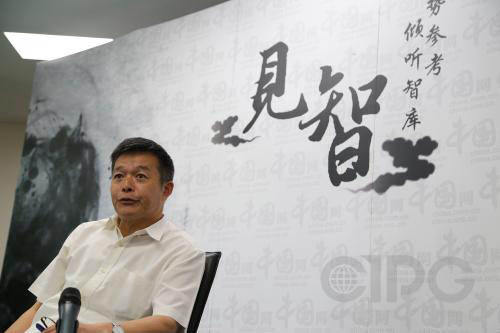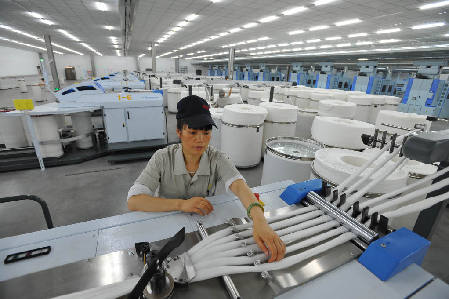By HU ANGANG
REVIEW and discussion of proposals with respect to the 13th Five-Year Plan (2016-2020) was a priority item on the agenda of the Fifth Plenary Session of the 18th CPC Central Committee in October 2015. The overall strategic goal of the plan is to complete the building of a moderately prosperous society in all respects.
 |
|
Hu Angang, the author. |
The Process of Formulating the New Plan with Chinese Characteristics
Under the mechanism of decision-making with Chinese characteristics, the state formulates national development plans for specific periods in a sustainable and continuous fashion. The goals put forward at the 16th, 17th and 18th national congresses of the Communist Party of China (CPC) have remained consistent: to complete the building of a moderately prosperous society in all respects.
The formulation of the 13th Five-Year Plan comprised four phases.
The first phase confirmed the goals of the new five-year plan completed at the 18th National Congress of the CPC. The Report to the 18th CPC’s National Congress raised a general outline of the targets to be achieved by 2020 which set the guiding principles and themes as well as major goals of the 13th Five-Year Plan.
The second phase consisted in raising a proposal on the Plan at the Fifth Plenary Session of the 18th CPC Central Committee. In October, the Party put forward a proposal with regard to the 13th Five-Year Plan and, after deliberation and discussion by various sectors and all levels of administrative authorities, developed a detailed program.
The third phase was that of putting the proposal under discussion and scrutiny, and was organized by the State Council. Upon announcement of the proposal, the State Council entrusted the National Development and Reform Commission and the State Development and Planning Expert Committee with the drafting of the outline of the 13th Five-Year Plan, which was placed online to solicit public opinions and suggestions. The State Council considered opinions from all walks of society and prepared for the National People’s Congress (NPC) to be held on March 5, 2016.
The fourth and final phase is official deliberation and discussion at the National People’s Congress next year. NPC deputies will vote on the new Plan, and formulate a resolution followed by an official announcement.
Prior to NPC deliberations, the special committees of the NPC and also the Chinese People’s Political Consultative Conference (CPPCC) carry out research on and discuss the plan. The special committees under the NPC will also submit 24 reports on different topics. Different from Western countries, China’s decision-making mechanism is geared specifically to its particular situation. Through investigation and research, political consultation and information sharing, a political consensus is reached whereby the NPC makes a final decision.
Hard-gained Fruits of the 12th Five-Year Plan
The year 2015 marks completion of the 12th Five-Year Plan. During the period from 2011 to 2015, China made significant progress in economic, social, cultural, political, and ecological development, and its macro economy sustained stable growth. In the period during which the global economy suffered a general downturn, world trade experienced either low or negative growth. As China had integrated more closely with the world, these exterior changes greatly affected the country. The achievements made during this period as regards economic, technological, and comprehensive strength are hence of particular value.
Secondly, China’s economic aggregate reached a new level. According to the World Bank, China’s GDP grew from US $6 trillion in 2010 to US $10 trillion in 2014 (on a three-year weighted average exchange rate). Compared to the U.S., which reached the US $10 trillion benchmark in 2000, therefore, China lagged 14 years behind achievement of the same target. However, in 2014 China’s per capita GDP reached US $7,380, as compared with US $4,300 in 2010, so signifying China’s entry to the middle to higher income strata (a per capita GDP of US $4,000).
Thirdly, China successfully boosted domestic demand, especially consumer demand – a hard nut to crack during the 10th and 11th Five-Year Plan periods. Modernization of China’s infrastructure has been another focus of the 12th Five-Year Plan. Between 2010 and 2015, China made major progress in the following areas: railways and high-speed rail; road networks; highways, roads in rural areas in particular; the Internet; and energy infrastructure, especially its power generating and transmission capacities, both of which ranked first in the world. At present, there are one billion people without electricity in the world, and China eliminated 250,000 of its population living without electricity last year. In 1949 China produced just 1.2 percent of the total power generated by the U.S. It has since surpassed America in this respect by a factor of 1.4. Power generation capacity and the proportion of people living without electricity thus signify that power generation in relation to power supply constitutes the most important modernization factor in the process of a country’s development.
When evaluating the 24 indexes proposed (29 in total, including additions) in the 12th Five-Year Plan, China over-fulfilled 10 indexes in 2014, nigh-on fulfilled four indexes (90 percent completed), and made steady progress in nine indexes. The non-fossil energy consumption rate and construction of low-income housing were the sole two indexes that failed to achieve an 80-percent completion rate.
The 12th Five-Year Plan mid-term evaluation scored 93.1 points, as compared with the just over 60 – a mere passing grade – of the 10th Five-Year Plan, and the 11th Five-Year Plan’s 87 points. These changes reflect the substantial improvements in China’s state governance performance. The five-year plans are a process of study and practice. We thus learn from past lessons and improve our governance capacity – a truly unique way of governing the country.
 |
|
A workshop in a cotton factory at the Korla Economic and Technological Development Zone, Bayingolin Mongolian Autonomous Prefecture, Xinjiang Uygur Autonomous Region. |
Major Concerns of the 13th Five-Year Plan
The 13th Five-Year Plan period plays a decisive role in ensuring completion of the building of a moderately prosperous society in all respects.
As the world’s second largest economy, China is the strongest engine powering global economic growth. Over the past four years, China contributed one third of global economic growth, roughly double that of the U.S. The country’s economy, therefore, has polarized global attention. But China now proposes a shift from the GDP-centric criteria with which the change of China’s growth model is so closely connected. The author believes that the growth target of the 13th Five-Year Plan period will be set at around seven percent. Currently China is experiencing an economic downturn that will hit bottom at the end of this year. It is possible that the 13th Five-Year Plan period will usher in a new round of growth.
China still has great potential for growth, the results of which will likely exceed our expectations. This is because China is in an era of synchronized momentum towards urbanization, modernization, informationization (also known as the Internet Plus), agricultural modernization, and infrastructure modernization. The accent in all five areas is on ecological conservation. We have good reason to believe that China’s future growth will be maintained at around seven percent or higher.
Ensuring that workers, especially those in the private sector and who are self-employed, have access to various insurances and basic public services is essential in the long term. From this perspective, the five-year plans indeed “promote human all-around development.” We must, therefore, further improve public services and boost employment, education, healthcare, and other indexes vital to people’s lives, and at the same time reduce economic anticipated indexes. The design of the 12th Five-Year Plan indexes reduced economic development indicators to three, or 12.5 percent, all of which were anticipated. In contrast, during the Sixth Five-Year Plan period (1981-1985) shortly after the reform and opening-up policy was initiated, 60 percent of the indicators were obligatory economic targets.
The main issue now is that of low-income housing in urban areas. Bearing in mind the constant change and flow of population and labor force, basic housing could be the issue demanding most attention during the 13th Five-Year Plan period. The target – a home for every urban resident – is also a key obligatory indicator that must be fulfilled by both the central and local governments.
The period between now and 2030 will bring important strategic opportunities for China amid the country’s transition from a moderately prosperous society to a prosperous society for all, with an income level that has advanced from the middle to higher level. As a transitional period in which to achieve the strategic goals of modernization, it will be integral to comprehensively building a modernized country, comprehensively deepening reform, comprehensively implementing the rule of law, and comprehensively carrying out innovation.
HU ANGANG is dean of the Institute of Contemporary China Studies and professor at the School of Public Policy and Management, Tsing-hua University.

